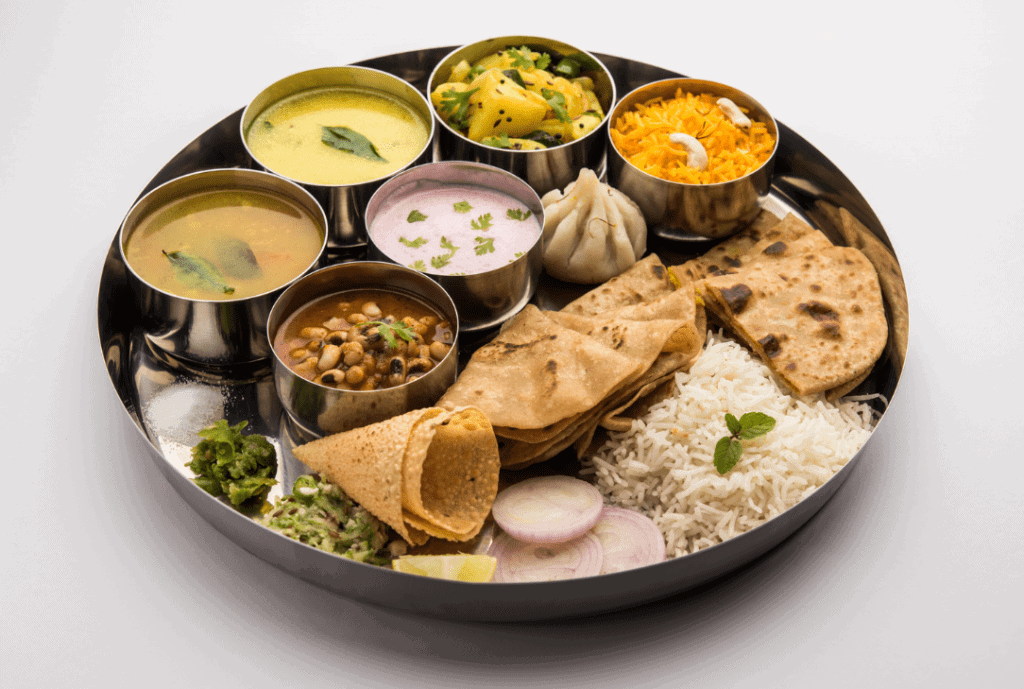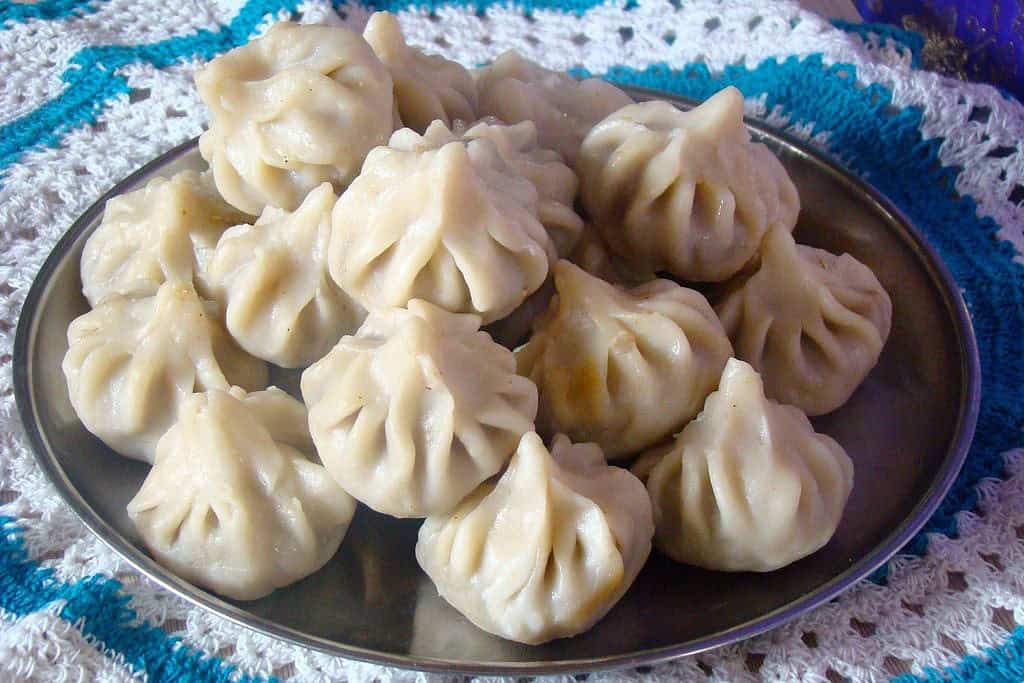Ever felt tired of eating the same old lunch every day? Not a problem anymore because we are a nation with unity in diversity and so is the case with the dishes we have, diverse & unique – presenting Maharashtra on your plate!

Maharashtra, a state known for its vibrant culture, brings an incredible variety of dishes to your plate. From the coastal flavours of Konkan to the spicy delights of Kolhapur, each meal offers a unique experience.
These 10 iconic dishes not only celebrate Maharashtra’s culinary heritage but also promise to upgrade your lunch in the most delicious way possible. So, let’s check out these irresistible dishes that make Maharashtrian cuisine truly unforgettable!
Puran Poli (Statewide)
Puran Poli is a cherished dish in Maharashtra, deeply rooted in its festive traditions. This sweet flatbread is often prepared during Holi, Ganesh Chaturthi, and other special occasions. The combination of jaggery and chana dal in the stuffing, flavoured with nutmeg and cardamom, creates a deliciously sweet and aromatic treat.
Recipe: Chana dal is cooked until soft and mashed into a smooth paste, then combined with jaggery, cardamom, and nutmeg powder to form the puran. The wheat flour dough is kneaded soft and pliable, rolled out, and stuffed with the puran. After sealing the edges, the Poli is rolled flat and roasted on a tawa with a drizzle of ghee until golden brown. It is traditionally served with warm milk or a dollop of ghee for an authentic experience.
Solkadhi (Konkan)
Solkadhi is a refreshing drink made with kokum and coconut milk, perfect for cooling down after a spicy meal. Known for its tangy and mildly spicy flavour, it also aids digestion.
Recipe: Kokum (fruit) is soaked in warm water to extract its juice, which is then mixed with coconut milk, garlic paste, green chillies, and salt. The drink is served chilled and often accompanies seafood meals, making it a staple in Konkan households. Its unique flavour profile is both soothing and invigorating.
Pandhra Rassa and Tambda Rassa (Kolhapur)
These two curries are the pride of Kolhapur, renowned for their bold flavours and aromatic spices. Pandhra Rassa, or white curry, has a creamy texture derived from coconut milk, offering a mild taste. Tambda Rassa, or red curry, is a fiery delight made with Kolhapuri masala, giving it a robust and spicy taste. Together, they showcase the contrasting yet complementary sides of Kolhapuri cuisine.
Recipe: For Pandhra Rassa, the mutton stock is infused with coconut milk, ginger, garlic, and a dash of green chilli for a subtle spice kick. Tambda Rassa, on the other hand, is made of slow-cooking mutton stock with a base of Kolhapuri masala, red chilli powder, and onions for a rich, vibrant curry. Both are best enjoyed with bhakri or steamed rice.
Zunka Bhakri (Marathwada)
Jhunka or Zunka Bhakri is a staple of Marathwada’s rural households, reflecting the simplicity and wholesomeness of the region’s cuisine. Zunka is a spicy and crumbly preparation made with chickpea flour, while bhakri, a flatbread made of jowar or bajra, complements it perfectly. This meal is a powerhouse of nutrition and flavour.
Recipe: The zunka is prepared by sautéing garlic, mustard seeds, curry leaves, and green chillies in oil, then adding chickpea flour and water to achieve a crumbly texture. The bhakri is made by kneading jowar or bajra flour into a soft dough, rolling it out, and roasting it on a hot tawa. Together, they form a hearty meal, often served with a side of chutney or pickle.
Bombil Fry (Mumbai)
Bombil Fry is a signature dish of Mumbai’s coastal cuisine, celebrating the flavours of Bombay duck, a fish unique to the Konkan coast. Known for its crispy crust and tender interior, this dish is a seafood lover’s dream.
Recipe: The fish is cleaned, marinated with turmeric, red chilli powder, and salt, and then coated in a mix of rice flour and semolina for a crispy texture. It is shallow-fried in oil until golden brown and served hot. Bombil Fry pairs excellently with steamed rice and dal or can be enjoyed as a standalone appetizer.
Shev Bhaji (Vidarbha)
Shev Bhaji is a deliciously spicy curry from Vidarbha, combining the crispiness of sev (fried gram flour noodles) with a rich and flavourful gravy. The dish is a perfect example of Vidarbha’s bold and fiery cuisine.
Recipe: The gravy is prepared with a base of onions, tomatoes, garlic, and Vidarbha’s unique goda masala. Spices like turmeric, chilli powder, and garam masala add depth to the dish. The sev is added just before serving, allowing it to absorb the flavours of the curry without losing its texture. Shev Bhaji is traditionally served with chapati or steamed rice.
Kharvas (Western Maharashtra)
Kharvas is a unique dessert made from the colostrum milk of cows or buffaloes, known for its soft and creamy texture. This delicacy is typically prepared during special occasions, offering a mildly sweet and aromatic flavour.
Recipe: Colostrum milk is mixed with regular milk, jaggery, sugar, and cardamom powder to create a smooth mixture. It is then poured into a dish, steamed, and allowed to set. The result is a custard-like dessert, garnished with saffron strands for a touch of elegance. Kharvas is served chilled and savoured for its delicate flavour.
Kothimbir Vadi (Mumbai and Konkan)
Kothimbir Vadi is a popular Maharashtrian snack made from coriander leaves (kothimbir) and gram flour. With its crispy exterior and flavorful interior, this dish is a perfect tea-time companion or a side dish at meals.
Recipe: Gram flour is mixed with finely chopped coriander, green chillies, garlic, sesame seeds, and spices to create a thick batter. The batter is steamed until firm, cut into pieces, and shallow-fried until golden brown. The vadis are served hot, often with green chutney or ketchup, for a delightful snack.
Amti Dal (Marathwada)
Amti Dal is a comforting lentil dish known for its tangy and mildly sweet taste. Tamarind adds a hint of sourness, while jaggery brings a touch of sweetness. The use of goda masala, a traditional Maharashtrian spice blend, makes it unique and authentic.
Recipe:
Toor dal (split pigeon peas) is cooked until soft. It is tempered with mustard seeds, curry leaves, and green chillies. Tamarind pulp and jaggery are added to create a balance of sour and sweet. Finally, goda masala is stirred in to complete the dish. Serve it hot with steamed rice and a dollop of ghee for a wholesome meal.
Ukadiche Modak (Konkan and Pune)
This is a steamed sweet dumpling, loved for its soft rice flour covering and delicious coconut-jaggery filling. It is considered Lord Ganesha’s favourite food and is a must-have during Ganesh Chaturthi. This dish is cherished for its unique taste and festive significance.

Recipe:
To make Ukadiche Modak, rice flour is mixed with hot water and a little salt to form a smooth dough. The filling is made by cooking grated coconut with jaggery until it turns thick and aromatic, with cardamom added for flavour. The dough is rolled into small discs, stuffed with the sweet filling, and shaped into dumplings. These are then steamed until soft. Adding a drizzle of ghee enhances the taste and makes them even more delightful.
Maharashtra’s culinary landscape is as diverse as its culture, offering a rich blend of flavours, textures, and traditions. Each dish reflects the region it comes from, making lunch an exciting journey through the state’s gastronomic heritage. Whether it’s the sweetness of Puran Poli, the spice of Tambda Rassa, or the cooling touch of Solkadhi, these dishes bring something unique to the table. Try these recipes to experience the magic of Maharashtra on your plate and redefine your lunchtime with a burst of authentic flavours!
A nutritional powerhouse
A typical Maharashtrian meal is a nutritional powerhouse, carefully crafted to balance macronutrients and micronutrients. It often includes staples like bhakri (flatbread made from jowar, bajra, or rice flour), which are excellent sources of complex carbohydrates and dietary fibre, promoting sustained energy and digestive health. Dals and legumes, such as varan (a simple lentil curry), contribute plant-based proteins essential for muscle repair and overall growth. The inclusion of seasonal vegetables, whether in a spicy bharli vangi (stuffed brinjal curry) or mixed vegetable preparation, ensures a good dose of vitamins, minerals, and antioxidants. Coconut, frequently used in curries and chutneys, adds healthy fats that aid in nutrient absorption and brain health.
Fermented foods like idli, dhokla, or amboli (a rice and urad dal pancake) feature prominently in Maharashtrian cuisine and provide probiotics for gut health. Side dishes like thecha (a spicy chilli-garlic chutney) are rich in antioxidants, while sol kadhi, made with kokum, helps cool the body and aids digestion. Traditional desserts like puran poli are nutrient-dense, combining the goodness of jaggery (a natural source of iron) and lentils, making them both indulgent and nourishing. The use of turmeric, a cornerstone of Indian cooking, adds anti-inflammatory properties to meals, enhancing overall health and immunity.
The cooking methods employed in Maharashtrian cuisine further contribute to its nutritional value. Many dishes are steamed, roasted, or lightly stir-fried, preserving the essential nutrients of the ingredients. The cuisine’s reliance on natural flavourings, such as tamarind, kokum, and fresh coriander, minimizes the need for excessive oil or artificial additives. This wholesome approach not only caters to diverse palates but also supports a balanced diet, making Maharashtrian meals a delicious and health-conscious choice for individuals seeking both tradition and wellness on their plate.
Read more: Latest



